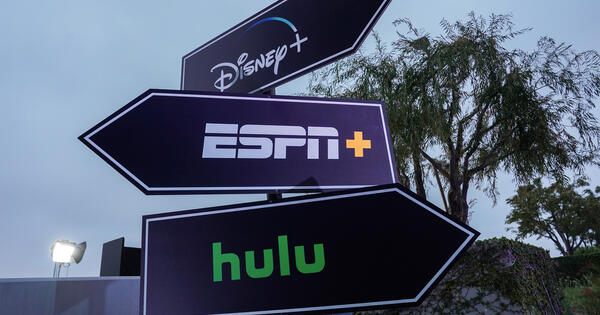
Q: When we talked two years ago, you described an industry in search of a profitable business model. You warned that companies would be in for a tough stretch. Where do things stand now?
It’s been a very difficult two years for the entertainment sector— worse than we could have imagined—and streaming is a big part of why. People have continued dropping pay TV, which was a very profitable business, for streaming, which has proved to be an unprofitable business for everyone but Netflix and now Disney.
That means the streaming companies that have not scaled are facing a real reckoning. How do they stay viable? Do they cut back on investment spending? Do they raise prices? Do they merge? Do they exit the business?
Q: When you say viable, do you see bankruptcies coming?
It’s not that there’s an immediate risk of bankruptcy. But the stock prices of many of these companies have fallen by half or two-thirds, and the question of how to move to profitability is now front and center.
Pay TV isn’t coming up on a cliff, but it is and has been on a long downward slope. They can model it out. If their customer base shrinks 7% every year, how long can the networks live with such a big negative profit squeeze?
For streaming, the average number of services per household has been stuck at four for a while. One of those four is Netflix, the second is Amazon—it comes with Prime—and third is some combination of Disney’s offerings. Fourth place is up for grabs. That’s what all the rest are fighting over.
For example, in the past six months, Paramount has gone through contortions trying to figure out what to do. They were about to do a merger, then they slowed that way down. I think their newest plan is to just reduce costs, and maybe, at some point, exit streaming.
Q: If Paramount or others exit streaming does that mean they focus on making content?
The phrase people have been using is “arms dealing.” Rather than making content for your own platform, just sell your stuff to the highest bidder. Paramount can keep making Yellowstone and shows like it and just license them to third parties to stream. Same for its movies.
We need fewer platforms and fewer companies in the space. There are four or five companies that are subscale; there needs to be more consolidation. There’s too much capital investment in this space. We’re already seeing a reduction of capital investment, but consolidation would further it.
Q: Disney, Hulu and Max announced a bundle. There’s a sports bundle coming from Warner Bros. Discovery, Disney, and Fox. What is bundling about?
If you go back to the original pay TV model, it was a bundle of four or five entertainment company products. In effect, everyone shared responsibility for delivering programming to a wide audience. By doing that, they were able to program to a complete household’s tastes and limit churn—customers’ canceling their subscription. In one month, the NCAA men’s and women’s basketball tournament kept you in the pay TV bundle. Then it would be the NBA or NHL playoffs, then it’d be Shark Week, and then it’d be the new television season, then the NFL.
The streaming model is great for consumers, but it’s a terrible business model because people binge the shows they’re interested in, then churn off the product.
Cable was a very stable, profitable business model for a long time until it was disrupted by streaming. We’ve always argued the streaming model is great for consumers, but it’s a terrible business model because people binge the shows they’re interested in, then churn off the product.
Companies don’t want to lose any customers. But, in streaming, losing just 25% of your customer base is a good number. Losing 35% every year is average. The best option for replacing the lost customers is adding new content. Content is expensive. So we’re seeing bundling. The hope is that, in any given month, some part of the bundle will have content offerings that keep households subscribed.
What we’ve learned is that streaming is just too difficult of a business model. We came from an approach where everyone pitched in together to reduce churn and drive pricing. Streaming asked everyone to go at it alone. And it’s been very, very hard.
For streaming to work, it’s going to have to look a lot like cable bundles. That’s the great irony. Companies had it pretty darn good with cable, so it’s going to be hard to get back to those economics again.
Q: Netflix has managed to be profitable. How did they do it?
Two years ago, Netflix had hit a wall on subscriber growth. They had also raised price to the point where they were creating higher churn. What they did in response was pretty ingenious. They offered an advertising tier at a much lower price.
That pretty much has restarted growth for Netflix. They also cracked down on password sharing, which has added some subscriptions.
Q: Is there any sign of a pushback from the password crackdown?
Originally, they rolled it out in Canada. They did it all at once, and Canadians were quite upset. So, in the U.S., Netflix has used a rolling strategy for the crackdown. Consumer anger hasn’t built up; they did a good job to defuse the situation. Overall, it’s been very good for Netflix.
We’ve been surprised by how profitable Netflix has become. Their revenues have accelerated as their cost base has flattened. They have added ads, added subscribers through the password-sharing crackdown, and they have slowed their spending on content. They’re in a league of their own.
Of the legacy companies, Disney has the best hand because it has Hulu, Disney+, ESPN+. They have great content. What they’re trying to do now is put it all together to create a super product, which I think is going to work.
Q: AI is everywhere. Is it going to impact this industry?
We’re watching disruption in real time. More and more movies and TV shows will be generated largely on a computer. Much in the way computers have transformed visual effects, AI will start to replace on-location shooting. As it gets better with fixing sound, there may not be as much need for sound stages. And AI can reduce the cost of editing. As shooting and post-production costs come down, that’s very good for the companies that make movies and TV shows. But because AI is doing that for everyone, it will create new competitors both among content producers and among platforms.
AI is going to help platforms tailor content and advertising on an individual basis. When I turn on ESPN, I’ll get content about the New York Rangers without having to wade through content about other teams. On Netflix, it’ll do a much better job suggesting things I will want to watch. And the targeting of ads will be much better. I will get more sophisticated advertising delivered to me. You will get different, sophisticated ads delivered to you.
It’s going to be an arms race to compete in AI. Given those costs, it probably creates even bigger advantages for the companies that have the balance sheets to invest in the tools—Alphabet, Amazon, Apple, and Meta.
I think the next time we talk we’ll spend a lot of time on AI.
“The Yale School of Management is the graduate business school of Yale University, a private research university in New Haven, Connecticut.”
Please visit the firm link to site


